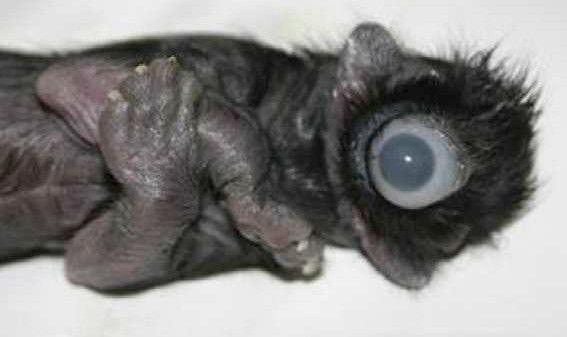

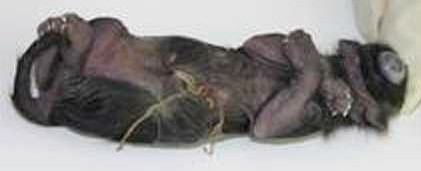
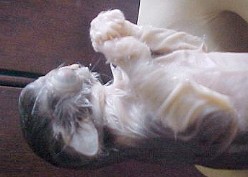
FELINE MEDICAL CURIOSITIES: CYCLOPIA, HOLOPROSENCEPHALY
Note: Contrary to suggestions on some bulletin boards, the images here are not photoshop. With the exception of those labelled as artist's impressions these are photos of medical conditions. These pages are intended as a medical reference site. Offsite links to images on these pages is not supported - bandwidth costs money!
CYCLOPIA
Cyclopia or synophthalmia (known medically as holoprosencephaly (HPE)) is a gross lethal deformity of the skull. The eyes are fused into a single enlarged eye that is placed below the nose (the nose may or may not form, if it forms it resembles a proboscis). Much of the face may be missing, such that the eye and proboscis (if present) are placed near the crown of the skull. Cyclopia results from a failure of the embryo's forebrain to divide into 2 hemispheres. It can result from defective genes or from certain toxins. These seem to interrupt development by interfering with a protein called Sonic hedgehog (Shh). Severe cases of cyclopia result in stillbirth or in death within a few hours of birth. Severely affected kittens will show primitive reflex actions (crying, swallowing etc), but have no higher brain functions.
This is a report from 1929: “ ‘Unsere Katze’ [German cat magazine] reports a weird “freak" kitten born at Salzburg and now in the Museum of that wonderful old Austrian city. Normal in all other respects, the place where its face should have been was occupied by one large eye. It only lived for a few hours after birth.” (Cat Gossip, 11th September, 1929)
|
|
|
|
|
|
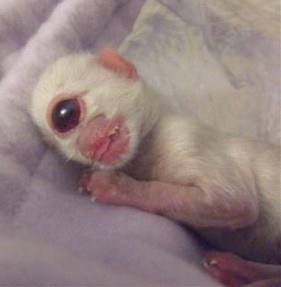 In January 2006, another cyclops kitten photo did the rounds of the internet (the white kitten, above right). Cy, short for Cyclopes, was a Ragdoll kitten born 28th December 2005 with only one eye and no muzzle. The owner, Traci Allen, raises Ragdolls in Redmond, Oregon. The litter contained only 2 kittens, this one and a normal sibling. Cy, photographed by the owner as a newborn (the fur appears slick from amniotic fluid rather than fluffy and dry), died after living for one day, was one of two in the litter. Many blogs and boards have claimed the photos to be fake, but have no knowledge of cranial defects to support their opinion. It is not a fake (after death, Cy was verified as real by veterinarian Karen Laidley, who examined the body). Although kittens do not open their eyes for 2 weeks, Cy has no eyelids and cannot close the eye (compare this with the black kitten where the eye protrudes from the skull). The eye is still moist, either from amniotic fluid or possibly from being moistened by the breeder (even normal kittens are sometimes born with open eyes). The bottow rim of the eye is incompletely fused. Although the head appears to be normal size, the eye is disproportionately large and occupies most of the central facial area - this is due to the abnormal growth of the facial structures associated with cyclopia. The internal structure of the eye is also defective: it lacks the pigmented iris that is blue in normal kittens; it has no blood vessels and no tapetum (the reflective layer that causes red-eye/green-eye in flash photography). The malformed brain means the eye is blind. The head is an abnormal shape with no muzzle and with the mouth presenting as a slit below the eyes.
In January 2006, another cyclops kitten photo did the rounds of the internet (the white kitten, above right). Cy, short for Cyclopes, was a Ragdoll kitten born 28th December 2005 with only one eye and no muzzle. The owner, Traci Allen, raises Ragdolls in Redmond, Oregon. The litter contained only 2 kittens, this one and a normal sibling. Cy, photographed by the owner as a newborn (the fur appears slick from amniotic fluid rather than fluffy and dry), died after living for one day, was one of two in the litter. Many blogs and boards have claimed the photos to be fake, but have no knowledge of cranial defects to support their opinion. It is not a fake (after death, Cy was verified as real by veterinarian Karen Laidley, who examined the body). Although kittens do not open their eyes for 2 weeks, Cy has no eyelids and cannot close the eye (compare this with the black kitten where the eye protrudes from the skull). The eye is still moist, either from amniotic fluid or possibly from being moistened by the breeder (even normal kittens are sometimes born with open eyes). The bottow rim of the eye is incompletely fused. Although the head appears to be normal size, the eye is disproportionately large and occupies most of the central facial area - this is due to the abnormal growth of the facial structures associated with cyclopia. The internal structure of the eye is also defective: it lacks the pigmented iris that is blue in normal kittens; it has no blood vessels and no tapetum (the reflective layer that causes red-eye/green-eye in flash photography). The malformed brain means the eye is blind. The head is an abnormal shape with no muzzle and with the mouth presenting as a slit below the eyes.
During its short life, the kitten was syringe-fed and made comfortable by the owner. The malformation of the brain means the kitten would not have suffered during its short life. It would have been rejected or killed by its mother. Following its death, the kitten's body was deep frozen in case it could be examined for research. The owner has been contacted by Ripley's Believe It Or Not and by the curators of the "Lost World" museum of oddities due to open near Syracuse, New York in 2006. Both want to display Cy. A Harvard University professor has requested a sample of Cy's DNA to study. In spite of the great interest in Cy and debate over the authenticity of the photos, news agencies declined to publish follow-up stories considering it to no longer be newsworthy.
Dr Keith Johnson of the Mountain View Veterinary Clinic delivered a cyclops kitten in the 1970s. He has kept the kitten's remains in a jar and shows it to those who ask to see it. Johnson noted that cyclopia is an extremely rare condition and he would be surprised if many more such kittens have been born. Most affected foetuses are aborted, or in the case of cats, reabsorbed, and do not reach full-term. Johnson noted that his one-eyed kitten was the result of inbreeding.

The three photos above are a cyclops kitten born to a Bengal breeder in November 2013. The kitten lived for 3.5 hours. The single eye appears to have 2 irides and pupils. Photos reproduced by kind permission of ClonzBorneo Cattery.
This was not the first Bengal born with cyclopia. In October 2012, a video and photos of a cyclopic Bengal called Cleyed went viral. Cleyed was born by emergency caesarian when his mother had difficulties delivering a litter. He was the second kitten delivered and died a short time afterwards. Although this death was attributed to suffocation, cyclopia caused brain abnormalities and is a lethal defect.
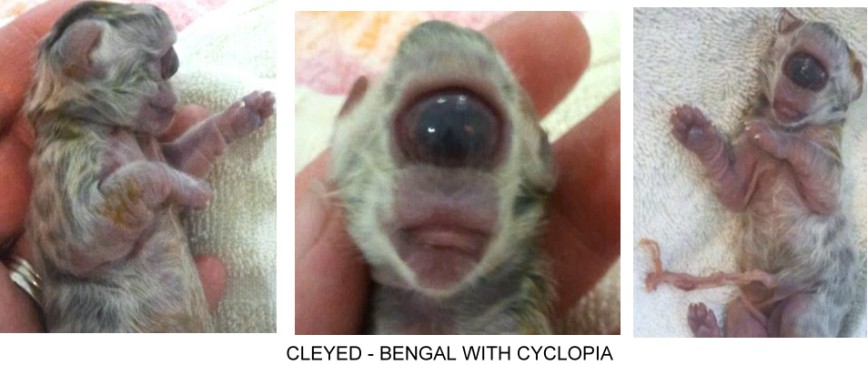
SEVERE HOLOPROSENCEPHALY
Some very extreme cases of holoprosencephaly/cyclopia have been described in cats. In these cases, the mouth and nose do not form and the only facial feature present is a large, centrally positioned eye. A veterinarian present at one such birth noted that the kitten was struggling for breath (a reflex action). Examination showed no mouth or nostrils present, resulting in suffocation once the kitten was no longer sustained by its umbilical cord. In the holoprosencephaly case below, the eye was also absent.
|
|
|
Tina Pollard's 3/4 Persian Milo produced this kitten in June 2007 along with a normal littermate. It lived for about 20 minutes. It looks like severe holoprosencephaly, essentially cyclopia but without the eye. Tina lives in rural New South Wales, Australia and unfortunately was unable to preserve the kitten or donate it to an anatomy museum. The vet was unable to offer a full explanation of the deformity and disposed of the body without further investigation.
If you compare the photos to those of the cyclopic kitten, you will see what appears to be the rim of an eyelid and ear flaps either side. No other facial structures, such as mouth or nostrils, are visible. There appears to be no cerebrum (forebrain) so the kitten was never conscious and did not suffer. Parts of the hindbrain would have allowed some reflex actions.
There are numerous cyclopic human infants preserved in medical museums. Cyclopia has been described in sheep, cattle and goats. Cyclopic infants, regardless of species, have a single monstrous eye in the middle of the forehead, underneath what remains of the nasal cavity. Those few that reach full term survive no more than a few days. The most usual cause is a mutation in the Sonic hedgehog gene and the degree of cyclopia depends on how badly the gene is damaged. Sonic hedgehog codes for a morphogen protein that instructs cells where they are, where to migrate to and what to become. When this protein malfunctions, the body’s geometry is disrupted to a greater or lesser degree. Before the eyes form, part of the forebrain (cerebrum) is dedicated to the brain wiring related to the eyes. Sonic hedgehog normally divides this region (optic field) into two smaller areas, one on either side i.e. one for each eye. If the gene malfunctions, only one optic field forms and there is either a single fused eye or two eyeballs in a single eye socket. The internal organs may also be affected depending on how badly the gene is damaged. If Sonic hedgehog is completely disabled, the embryo does not develop paws or a face, it just has an eyeless, earless, mouthless trunk in place of the head.
MORE ANOMALIES
If you have come to this page directly from a search engine, please check out
FELINE MEDICAL CURIOSITIES for the full index of topics includingBOOKS ABOUT ANOMALIES
If you are interested in medical curiosities, books worth reading are "Mutants: on the Form, Varieties and Errors of the Human Body" by Armand Marie Leroi and "Anomalies and Curiosities of Medicine Vols 1 and 2" by George M. Gould & Walter L. Pyle. The Gould & Pyle books were published in 1896 and are in the public domain. You can download text-only versions of Gould & Pyle from several websites so don't waste money on text-only versions of the book; but if you want the versions with photos, consider the Kessinger editions. The Leroi book explains why and how some deformities and anomalies happen - the mechanism is the same in cats as it is in humans.
You are visitor number